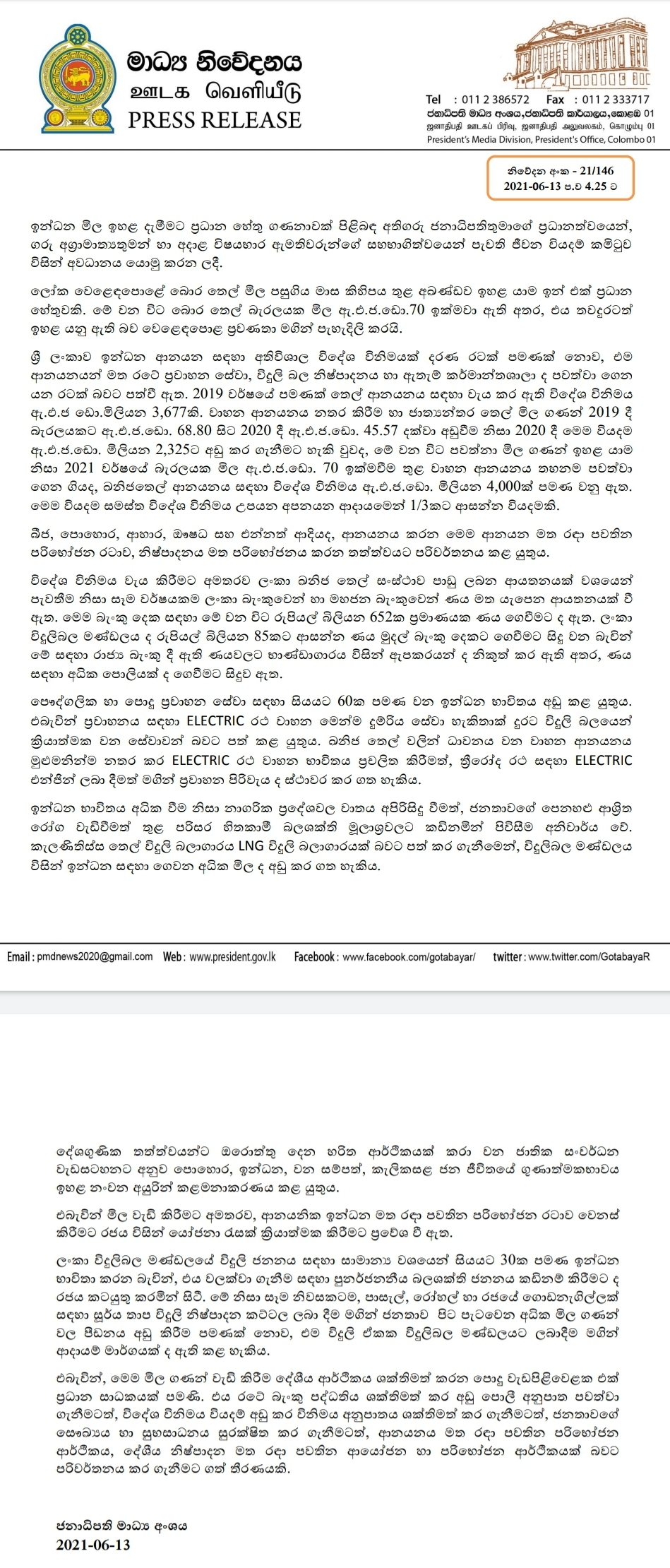Presidents office in a statement says that the latest fuel price hike is a step taken to stabilise national economy, bank interest rates, foreign reserves, and to secure & improve the health & welfare of the public.
“This price hike is one of the main factors of a public program which strengthens the national economy” President’s office said.
Full statement
The Cost of Living Committee, chaired by the President and convened with the participation of the Prime Minister and the Ministers in charge of the subject, focused on a number of main reasons for the need to increase fuel prices.
One of the main reasons for this is the continuous rise in global crude oil prices over the past few months. At present, the price of a barrel of crude oil is over US$ 70, and market trends indicate that it will continue to rise.
Sri Lanka has become a country that not only spends a large amount of foreign exchange for fuel imports, but also a country where its transport services, power generation and the function of some of the factories are based on these imports. In 2019 alone, the foreign exchange spent on oil imports was US$ 3,677 million. The cost spent for fuel imports was reduced to US$ 2,325 million in 2020 due to the ban on vehicle imports and the reduction in international oil prices to US$ 45.57 in 2020 from the previous price of US$ 68.80 in 2019. However, the price of a crude oil barrel in 2021 has exceeded US$ 70. Therefore, although the ban on vehicle imports was maintained, the expenditure from the foreign exchange earnings for petroleum imports would be around US$ 4,000 million. This amount is close to 1/3 of the total foreign exchange earned from the exports.
The import-dependent pattern of consumption which includes imports of seeds, fertilizers, food, pharmaceuticals and vaccines, must be transformed into a production-based pattern of consumption.
In addition to spending foreign exchange, the Ceylon Petroleum Corporation (CPC) has been a loss-making institution, relying on loans obtained from the Bank of Ceylon and the People’s Bank annually. The amount to be paid to the two banks as loans is Rs. 652 billion. As the Ceylon Electricity Board (CEB) has also to repay nearly Rs. 85 billion in loans to the two banks, the Treasury has issued bonds on loans given by the state banks and it has to pay a higher interest on the loans as well.
The private and public transportation accounts for nearly 60% of the fuel consumption and it should be reduced. Therefore, electric vehicles as well as electric rail transport have the potential to reshape the transportation sector in the country. Transport costs can also be stabilized by completely stopping the importation of new vehicles powered with fuel as well as promoting the use of electric vehicles and providing electric engines for three-wheelers.
Transitioning towards the use of eco-friendly energy sources is imperative due to an increase in lung related diseases in the population and increasing air pollution in urban areas caused by high fuel consumption. By converting the Kelanitissa Power Station into an LNG Power Plant, the Ceylon Electricity Board will also be able to reduce the higher costs for fuel.
According to the National Development Programme towards a Climate Resilient Green Economy, fertilizers, fuels, forest resources and garbage should be managed in a manner that enhances the quality of life of the people.
Therefore, in addition to increasing prices, the government has taken steps to implement a number of proposals to change the pattern of consumption based on imported fuels.
The government also aims to improve the renewable energy capacity to prevent 30 percent of fuel usage by the CEB for power generation. Therefore, providing solar thermal power kits to every household, school, hospital and government building will pave the way for the public to generate income by selling those units to the CEB while the pressure on the high cost borne by the people will also reduce.
Thus, these price increases are only one key factor in a common strategy that strengthens the local economy. It aims to strengthen the country’s banking system and maintain low interest rates, reduce foreign exchange spending and strengthen the exchange rate. Further, it is a decision taken to safeguard the health and welfare of the people and to transform the import-dependent consumer economy into an investment and consumer economy dependent on domestic production.
